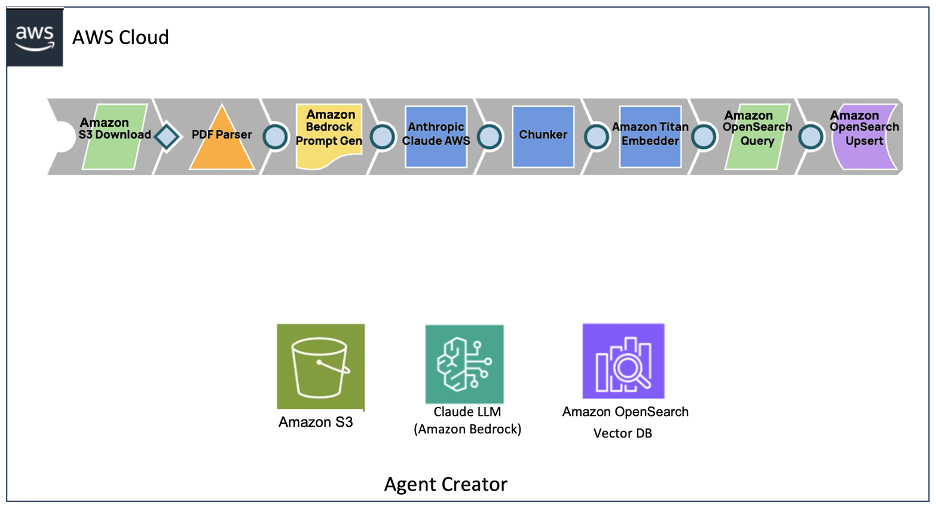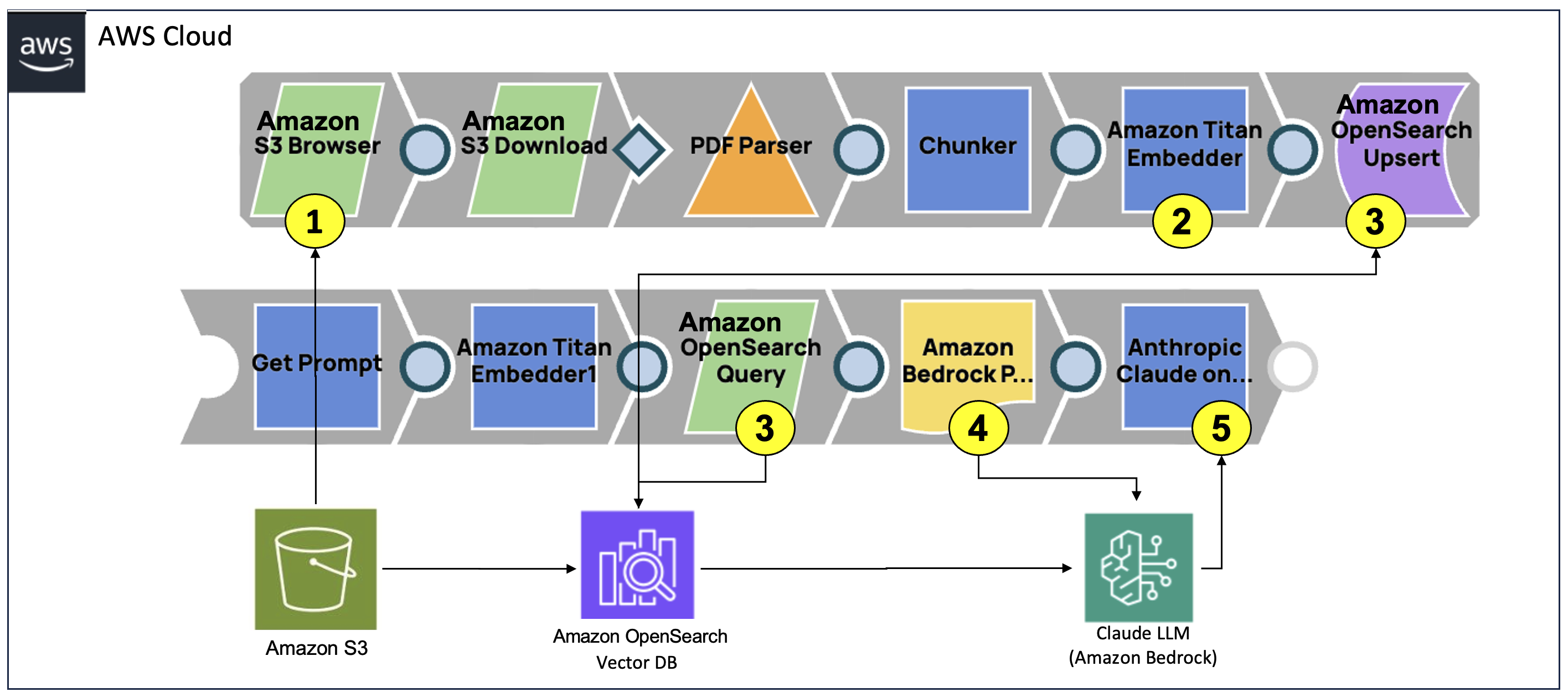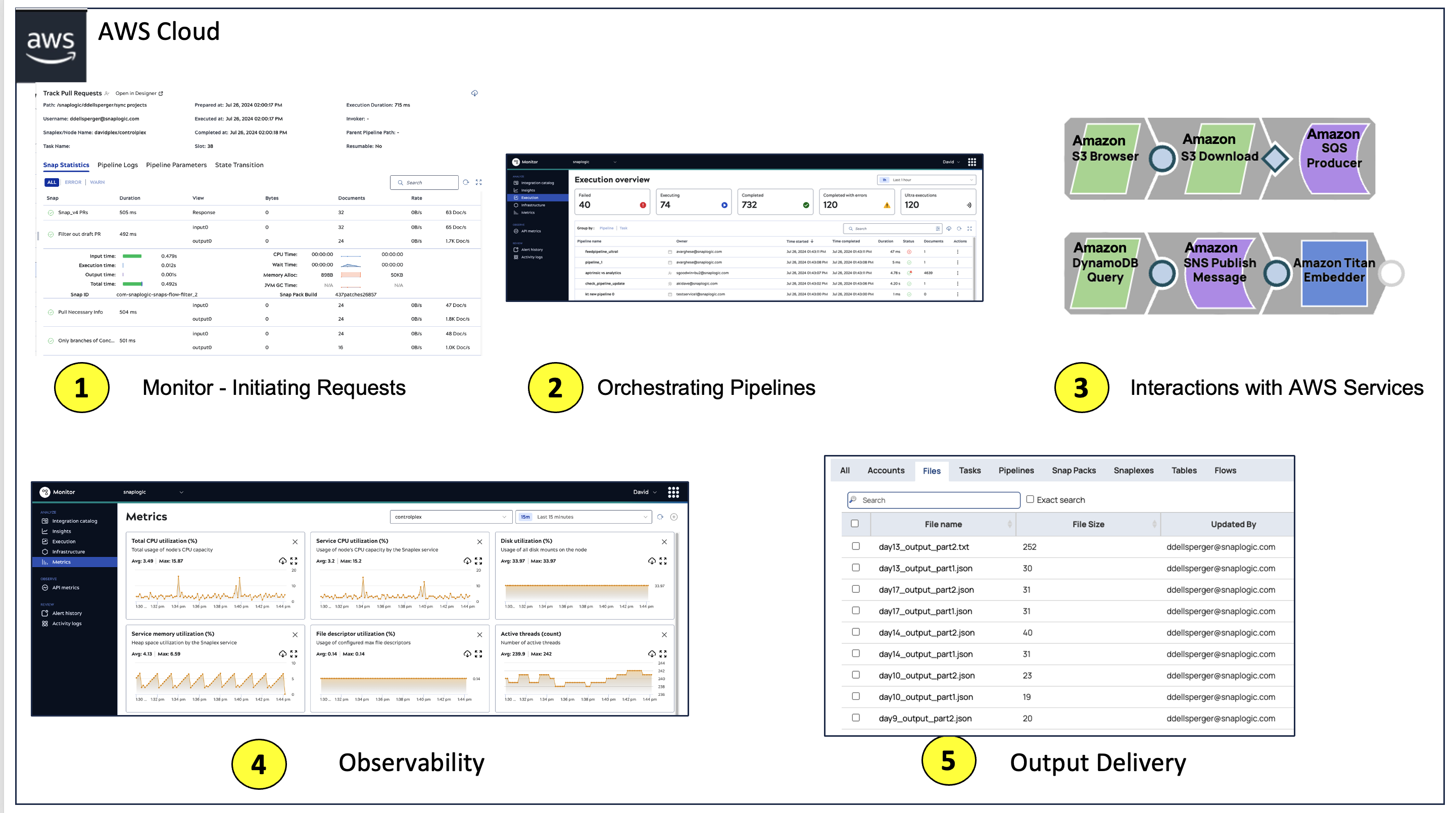This post is cowritten with Greg Benson, Aaron Kesler and David Dellsperger from SnapLogic.
The landscape of enterprise application development is undergoing a seismic shift with the advent of generative ai. SnapLogic, a leader in generative integration and automation, has introduced the industry’s first low-code generative ai development platform, Agent Creator, designed to democratize ai capabilities across all organizational levels. Agent Creator is a no-code visual tool that empowers business users and application developers to create sophisticated large language model (LLM) powered applications and agents without programming expertise.
This intuitive platform enables the rapid development of ai-powered solutions such as conversational interfaces, document summarization tools, and content generation apps through a drag-and-drop interface. By using SnapLogic’s library of more than 800 pre-built connectors and data transformation capabilities, users can seamlessly integrate various data sources and ai models, dramatically accelerating the development process compared to traditional coding methods. This innovative platform empowers employees, regardless of their coding skills, to create generative ai processes and applications through a low-code visual designer.
Pre-built templates tailored to various use cases are included, significantly enhancing both employee and customer experiences. Agent Creator is a versatile extension to the SnapLogic platform that is compatible with modern databases, APIs, and even legacy mainframe systems, fostering seamless integration across various data environments. Its low-code interface drastically reduces the time needed to develop generative ai applications.
Agent Creator
Creating enterprise-grade, LLM-powered applications and integrations that meet security, governance, and compliance requirements has traditionally demanded the expertise of programmers and data scientists. Not anymore! SnapLogic’s Agent Creator revolutionizes this landscape by empowering everyone to create generative ai–powered applications and automations without any coding. Enterprises can use SnapLogic’s Agent Creator to store their knowledge in vector databases and create powerful generative ai solutions that augment LLMs with relevant enterprise-specific knowledge, a framework also known as Retrieval Augmented Generation (RAG). This capability accelerates business operations by providing a toolkit for users to create departmental chat assistants, add LLM-powered search to portals, automate processes involving documents, and much more. Additionally, this platform offers:
- LLM-powered processes and apps in minutes – Agent Creator empowers enterprise users to create custom LLM-powered workflows without coding. Whether your HR department needs a Q&A workflow for employee benefits, your legal team needs a contract redlining solution, or your analysts need a research report analysis engine, Agent Creator provides the tools and flexibility to build it all.
- Automate intelligent document processing (IDP) – Agent Creator can extract valuable data from invoices, purchase orders, resumes, insurance claims, loan applications, and other unstructured sources automatically. The IDP solution uses the power of LLMs to automate tedious document-centric processes, freeing up your team for higher-value work.
- Boost productivity – Empowers knowledge workers with the ability to automatically and reliably summarize reports and articles, quickly find answers, and extract valuable insights from unstructured data. Agent Creator’s low-code approach allows anyone to use the power of ai to automate tedious portions of their work, regardless of their technical expertise.
The following demo shows Agent Creator in action.
To deliver these robust features, Agent Creator uses amazon Bedrock, a foundational platform that provides managed infrastructure to use state-of-the-art foundation models (FMs). This eliminates the complexities of setting up and maintaining the underlying hardware and software so SnapLogic can focus on innovation and application development rather than infrastructure management.
What is amazon Bedrock
amazon Bedrock is a fully managed service that provides access to high-performing FMs from leading ai startups and amazon through a unified API, making it easier for enterprises to develop generative ai applications. Users can choose from a wide range of FMs to find the best fit for their use case. With amazon Bedrock, organizations can experiment with and evaluate top models, customize them with their data using techniques like fine-tuning and RAG, and build intelligent agents that use enterprise systems and data sources. The serverless experience offered by amazon Bedrock enables quick deployment, private customization, and secure integration of these models into applications without the need to manage underlying infrastructure. Key features include experimenting with prompts, augmenting response generation with data sources, creating reasoning agents, adapting models to specific tasks, and improving application efficiency with provisioned throughput, providing a robust and scalable solution for enterprise ai needs. The robust capabilities and unified API of amazon Bedrock make it an ideal foundation for developing enterprise-grade ai applications.
By using the amazon Bedrock high-performing FMs, secure customization options, and seamless integration features, SnapLogic’s Agent Creator maximizes its potential to deliver powerful, low-code ai solutions. This integration not only enhances the Agent Creator’s ability to create and deploy sophisticated ai models quickly but also makes them scalable, secure, and efficient.
Why Agent Creator uses amazon Bedrock
SnapLogic’s Agent Creator uses amazon Bedrock to deliver a powerful, low-code generative ai development platform that meets the unique needs of its enterprise customers. By integrating amazon Bedrock, Agent Creator benefits from several key advantages:
- Access to top-tier FMs – amazon Bedrock provides access to high-performing FMs from leading ai providers through a unified API. Agent Creator offers enterprises the ability to experiment with and deploy sophisticated ai models without the complexity of managing the underlying infrastructure.
- Seamless customization and integration –The serverless architecture of amazon Bedrock frees up the time of Agent Creator developers so they can focus on innovation and rapid development. It facilitates the seamless customization of FMs with enterprise-specific data using advanced techniques like prompt engineering and RAG so outputs are relevant and accurate.
- Enhanced security and compliance – Security and compliance are paramount for enterprise ai applications. SnapLogic uses amazon Bedrock to build its platform, capitalizing on the proximity to data already stored in amazon Web Services (AWS). Because of this strategic decision, SnapLogic can offer enhanced security and compliance measures while significantly reducing latency for its customers. By processing data closer to where it resides, SnapLogic promotes faster, more efficient operations that meet stringent regulatory requirements, ultimately delivering a superior experience for businesses relying on their data integration and management solutions. Because amazon Bedrock offers robust features to meet these requirements, Agent Creator adheres to stringent security protocols and governance standards, giving enterprises confidence in their generative ai deployments.
- Accelerated development and deployment – With amazon Bedrock, Agent Creator empowers users to quickly experiment with various FMs, accelerating the development cycle. The managed infrastructure streamlines the testing and deployment process, enabling rapid iteration and implementation of intelligent applications.
- Scalability and performance – Generative ai applications built using Agent Creator are scalable and performant because of amazon Bedrock. It can handle large volumes of data and interactions, which is crucial for enterprises requiring robust applications. Provisioned throughput options enable efficient model inference, promoting smooth operation even under heavy usage.
By harnessing the capabilities of amazon Bedrock, SnapLogic’s Agent Creator delivers a comprehensive, low-code solution that allows enterprises to capitalize on the transformative potential of generative ai. This integration simplifies the development process while enhancing the capabilities, security, and scalability of ai applications, driving significant business value and innovation.
Solution approach
Agent Creator integrates amazon Bedrock, Anthropic’s Claude, and amazon OpenSearch Service vector databases to deliver a comprehensive and powerful low-code visual interface for building generative ai solutions. At its core, amazon Bedrock provides the foundational infrastructure for robust performance, security, and scalability for deploying machine learning (ML) models. This foundational layer is critical for managing the complexities of ai model deployment, and therefore SnapLogic can offer a seamless user experience. This integrated architecture not only supports advanced ai functionalities but also makes it easy to use. By abstracting the complexities of generative ai development and providing a user-friendly visual interface, Agent Creator offers enterprises the ability to use powerful AWS generative ai services without needing deep technical knowledge.
Control plane and data plane implementation
SnapLogic’s Agent Creator platform follows a decoupled architecture, separating the control plane and data plane for enhanced security and scalability.
Control plane
The control plane is responsible for managing and orchestrating the various components of the platform. The control plane is hosted and managed by SnapLogic, meaning that customers don’t have to worry about the underlying infrastructure and can focus on their core business requirements. SnapLogic’s control plane comprises several components that manage and orchestrate the platform’s operations. Here are some key components:
- Designer – A visual interface where users can design, build, and configure integrations and data flows
- Manager – A centralized management console for monitoring, scheduling, and controlling the execution of integrations and data pipelines
- Monitor – A comprehensive reporting and analytics dashboard that provides insights into the performance, usage, and health of the platform
- API management (APIM) – A component that manages and secures the exposure of integrations and data services as APIs, providing seamless integration with external applications and systems.
By separating the control plane from the data plane, SnapLogic offers a scalable and secure architecture so customers can use generative ai capabilities while maintaining control over their data within their own virtual private cloud (VPC) environment.
Data plane
The data plane is where the actual data processing and integration take place. To address customers’ requirements about data privacy and sovereignty, SnapLogic deploys the data plane within the customer’s VPC on AWS. This approach means that customer data never leaves their controlled environment, providing an extra layer of security and compliance. By using amazon Bedrock, SnapLogic can invoke generative ai models directly from the customer’s VPC, enabling real-time processing and analysis of customer data without needing to move it outside the secure environment. The integration with amazon Bedrock is achieved through the amazon Bedrock InvokeModel APIs. SnapLogic’s data plane, running within the customer’s VPC, calls these APIs to invoke the desired generative ai models hosted on amazon Bedrock.
Functional components
The solution comprises the following functional components:
- Vector Database Snap Pack – Manages the reading and writing of data to vector databases. This pack is crucial for maintaining the integrity and accessibility of the enterprise-specific knowledge stored in the OpenSearch vector database.
- Chunker Snap – Segments large texts into manageable pieces. This functionality is important for processing large documents so the ai can handle and analyze text effectively.
- Embedding Snap – Converts text segments into vectors. This step is vital for integrating enterprise-specific knowledge into ai prompts, enhancing the relevance and accuracy of ai responses.
- LLM Snap Pack – Facilitates interactions with Claude and other language models. The ai can generate responses and perform tasks based on the processed and retrieved data.
- Prompt Generator Snap – Enriches queries with the most relevant data so the ai prompts are contextually accurate and tailored to the specific needs of the enterprise.
- Pre-Built Pipeline Patterns for indexing and retrieving – To streamline the deployment of intelligent applications, Agent Creator includes pre-built pipeline patterns. These patterns simplify common tasks such as indexing, retrieving data, and processing documents so ai-driven solutions can be deployed without the need for deep technical expertise.
- Frontend Starter Kit – To simplify the deployment of user-facing applications, Agent Creator includes a Frontend Starter Kit. This kit provides pre-built components and templates for creating intuitive and responsive interfaces. Enterprises can quickly develop and deploy chat assistant UI applications, and applications not only function well but also provide a seamless and engaging user experience.

Data flow and control flow
In the architecture of Agent Creator, the interaction between Agent Creator platform, amazon Bedrock, OpenSearch Service, and Anthropic’s Claude involves a sophisticated and efficient management of data flow and control flow. By effectively managing the data and control flows between Agent Creator and AWS services, SnapLogic provides a robust, secure, and efficient platform for developing and deploying enterprise-grade solutions. This architecture supports advanced integration functionalities and offers a seamless, user-friendly experience, making it a valuable tool for enterprise customers.
Data flow
Here is an example of this data flow for an Agent Creator pipeline that involves data ingestion, preprocessing, and vectorization using Chunker and Embedding Snaps. The resulting vectors are stored in OpenSearch Service databases for efficient retrieval and querying. When a query is initiated, relevant vectors are retrieved to augment the query with context-specific data, and the enriched query is processed by the LLM Snap Pack to generate responses.

The data flow follows these steps:
- Data ingestion and preprocessing – Enterprise data is ingested from various sources such as documents, databases, and APIs. Chunker Snap processes large texts and documents by segmenting them into smaller, manageable chunks to make them compatible with downstream processing steps.
- Vectorization – The text chunks are passed to the Embedding Snap, which converts them into vector representations using embedding models. These vectors are numerical representations that capture the semantic meaning of the text. The resulting vectors are stored in OpenSearch Service vector databases, which manage and index these vectors for efficient retrieval and querying.
- Data retrieval and augmentation – When a query is initiated, the Vector Database Snap Pack retrieves relevant vectors from OpenSearch Service using similarity search algorithms to match the query with stored vectors. The retrieved vectors augment the initial query with context-specific enterprise data, enhancing its relevance.
- PromptResponse generation – The Prompt Generator Snap refines the final query so it’s well-formed and optimized for the language model. The language model generates a response, which is then postprocessed, if necessary, before delivery.
- Interaction with LLMs – The augmented query is forwarded to the LLM Snap Pack, which interacts with Anthropic’s Claude and other integrated language models. This interaction generates responses based on the enriched query.
Control flow
The control flow in Agent Creator is orchestrated between the control plane and the data plane. The control plane hosts the user environment, stores configuration settings and user-created assets, and provides access to various components. The data plane executes pipelines, connecting to cloud-based or on-premises data endpoints, with the control plane orchestrating the workflow across interconnected snaps. Here is an example of this control flow for a Agent Creator.

The control flow follows these steps:
- Initiating requests – Users initiate requests using Agent Creator’s low-code visual interface, specifying tasks such as creating Q&A assistants or automating document processing. Pre-built UI components such as the Frontend Starter Kit capture user inputs and streamline the interaction process.
- Orchestrating pipelines – Agent Creator orchestrates workflows using interconnected snaps, each performing a specific function such as ingestion, chunking, vectorization, or querying. The architecture employs an event-driven model, where the completion of one snap triggers the next step in the workflow.
- Managing interactions with AWS services – Agent Creator communicates with AWS services, including amazon Bedrock and OpenSearch Service, and Anthropic’s Claude in amazon Bedrock, through secure API calls. The serverless infrastructure of amazon Bedrock manages the execution of ML models, resulting in a scalable and reliable application.
- Observability – Robust mechanisms are in place for handling errors during data processing or model inference. Errors are logged and notifications are sent to system administrators for resolution. Continuous logging and monitoring provide transparency and facilitate troubleshooting. Logs are centrally stored and analyzed to maintain system integrity.
- Final output delivery – The generated ai responses are delivered to end user applications or interfaces, integrated into SnapLogic’s dashboards. User feedback is collected to continuously improve ai models and processing pipelines, enhancing overall system performance.
Use cases
You can use the SnapLogic Agent Creator for many different use cases. The next paragraphs illustrate just a few.
IDP on quarterly reports
A leading pharmaceutical data provider empowered their analysts by using Agent Creator and AutoIDP to automate data extraction on pharmaceutical drugs. By processing their portfolio of quarterly reports through LLMs, they could ask standardized questions to extract information that was previously gathered manually. This automation not only reduced errors but also saved significant time and resources, leading to a 35% reduction in costs and a centralized pool of reusable data assets, providing a single source of truth for their entire organization.
Automating market intelligence insights
A global telecommunications company used Agent Creator to process a multitude of RSS feeds, extracting only business-relevant information. This data was then integrated into Salesforce as a real-time feed of market insights. As the customer noted, “This automation allows us to filter and synthesize crucial data, delivering targeted, real-time insights to our sales teams, enhancing their productivity without the need for individual ai licenses.”
Agent Creator amazon Bedrock roadmap
Development and improvement are ongoing for Agent Creator, with several enhancements released recently and more to come in the future.
Recent releases
Extended support for more amazon Bedrock capabilities was made available with the August 2024 release. Support for retrieving and generating against amazon Bedrock and amazon Bedrock Knowledge Bases through snap orchestration was added as well as support for invoking amazon Bedrock Agents. Continual enhancements for new models and additional authentication mechanisms have been released supporting AWS Identity and Access Management (IAM) role authentication and cross-account IAM role authentication. All Agent Creator LLM Snaps have also been updated to support a more raw request payload, adding support to specify entire conversations (for continued conversations) as well as the ability to specify prompts beyond just text.
Support for the amazon Bedrock Converse API was released recently. With the amazon Bedrock Converse API support, Agent Creator is able to support models beyond amazon Titan and Anthropic’s Claude. This comes with added support for multi-modal prompt capabilities, which is delivered through new Snaps to orchestrate the building of these more complex payloads.
SnapLogic has revolutionized enterprise ai with its Agent Creator, the industry’s first low-code generative ai development platform. By integrating advanced generative ai services such as amazon Bedrock and OpenSearch Service vector databases and cutting edge LLMs such as Anthropic’s Claude, SnapLogic empowers enterprise users, from product to sales to marketing, to create sophisticated generative ai–driven applications without deep technical expertise. This platform reduces dependency on specialized programmers and accelerates innovation by streamlining the generative ai development process with pre-built pipeline patterns and a Frontend Starter Kit.
Agent Creator offers robust performance, security, and scalability so enterprises can use powerful generative ai tools for competitive advantage. By pioneering this comprehensive approach, SnapLogic not only addresses current enterprise needs but also positions organizations to harness amazon Bedrock for future advancements in generative ai technology, driving significant business value and operational efficiency for our enterprise customers.
To use Agent Creator effectively, schedule a demo of SnapLogic’s Agent Creator to learn how it can address your specific use cases. Identify potential pilot projects, such as creating departmental Q&A assistants, automating document processing, or putting an LLM to work for you behind the scenes. Prepare to store your enterprise knowledge in vector databases, which Agent Creator can use to augment LLMs with your specific information through RAG. Begin with a small project, such as creating a departmental Q&A assistant, to demonstrate the value of Agent Creator and use this success to build momentum for larger initiatives. To learn more about how to make best use of amazon Bedrock, refer to the amazon Bedrock Documentation.
About the authors
 Asheesh Goja is Principal Solutions Architect at AWS. Prior to AWS, Asheesh worked at prominent organizations such as Cisco and UPS, where he spearheaded initiatives to accelerate the adoption of several emerging technologies. His expertise spans ideation, co-design, incubation, and venture product development. Asheesh holds a wide portfolio of hardware and software patents, including a real-time C++ DSL, IoT hardware devices, Computer Vision and Edge ai prototypes. As an active contributor to the emerging fields of Generative ai and Edge ai, Asheesh shares his knowledge and insights through tech blogs and as a speaker at various industry conferences and forums.
Asheesh Goja is Principal Solutions Architect at AWS. Prior to AWS, Asheesh worked at prominent organizations such as Cisco and UPS, where he spearheaded initiatives to accelerate the adoption of several emerging technologies. His expertise spans ideation, co-design, incubation, and venture product development. Asheesh holds a wide portfolio of hardware and software patents, including a real-time C++ DSL, IoT hardware devices, Computer Vision and Edge ai prototypes. As an active contributor to the emerging fields of Generative ai and Edge ai, Asheesh shares his knowledge and insights through tech blogs and as a speaker at various industry conferences and forums.
 Dhawal Patel is a Principal Machine Learning Architect at AWS. He has worked with organizations ranging from large enterprises to mid-sized startups on problems related to distributed computing, and artificial intelligence. He focuses on Deep learning including NLP and Computer Vision domains. He helps customers achieve high performance model inference on SageMaker.
Dhawal Patel is a Principal Machine Learning Architect at AWS. He has worked with organizations ranging from large enterprises to mid-sized startups on problems related to distributed computing, and artificial intelligence. He focuses on Deep learning including NLP and Computer Vision domains. He helps customers achieve high performance model inference on SageMaker.
 Greg Benson is a Professor of Computer Science at the University of San Francisco and Chief Scientist at SnapLogic. He joined the USF Department of Computer Science in 1998 and has taught undergraduate and graduate courses including operating systems, computer architecture, programming languages, distributed systems, and introductory programming. Greg has published research in the areas of operating systems, parallel computing, and distributed systems. Since joining SnapLogic in 2010, Greg has helped design and implement several key platform features including cluster processing, big data processing, the cloud architecture, and machine learning. He currently is working on Generative ai for data integration.
Greg Benson is a Professor of Computer Science at the University of San Francisco and Chief Scientist at SnapLogic. He joined the USF Department of Computer Science in 1998 and has taught undergraduate and graduate courses including operating systems, computer architecture, programming languages, distributed systems, and introductory programming. Greg has published research in the areas of operating systems, parallel computing, and distributed systems. Since joining SnapLogic in 2010, Greg has helped design and implement several key platform features including cluster processing, big data processing, the cloud architecture, and machine learning. He currently is working on Generative ai for data integration.
 Aaron Kesler is the Senior Product Manager for ai products and services at SnapLogic, Aaron applies over ten years of product management expertise to pioneer ai/ML product development and evangelize services across the organization. He is the author of the upcoming book “What’s Your Problem?” aimed at guiding new product managers through the product management career. His entrepreneurial journey began with his college startup, STAK, which was later acquired by Carvertise with Aaron contributing significantly to their recognition as tech Startup of the Year 2015 in Delaware. Beyond his professional pursuits, Aaron finds joy in golfing with his father, exploring new cultures and foods on his travels, and practicing the ukulele.
Aaron Kesler is the Senior Product Manager for ai products and services at SnapLogic, Aaron applies over ten years of product management expertise to pioneer ai/ML product development and evangelize services across the organization. He is the author of the upcoming book “What’s Your Problem?” aimed at guiding new product managers through the product management career. His entrepreneurial journey began with his college startup, STAK, which was later acquired by Carvertise with Aaron contributing significantly to their recognition as tech Startup of the Year 2015 in Delaware. Beyond his professional pursuits, Aaron finds joy in golfing with his father, exploring new cultures and foods on his travels, and practicing the ukulele.
 David Dellsperger is a Senior Staff Software Engineer and Technical Lead of the Agent Creator product at SnapLogic. David has been working as a Software Engineer emphasizing in Machine Learning and ai for over a decade previously focusing on ai in Healthcare and now focusing on the SnapLogic Agent Creator. David spends his time outside of work playing video games and spending quality time with his yellow lab, Sudo
David Dellsperger is a Senior Staff Software Engineer and Technical Lead of the Agent Creator product at SnapLogic. David has been working as a Software Engineer emphasizing in Machine Learning and ai for over a decade previously focusing on ai in Healthcare and now focusing on the SnapLogic Agent Creator. David spends his time outside of work playing video games and spending quality time with his yellow lab, Sudo






